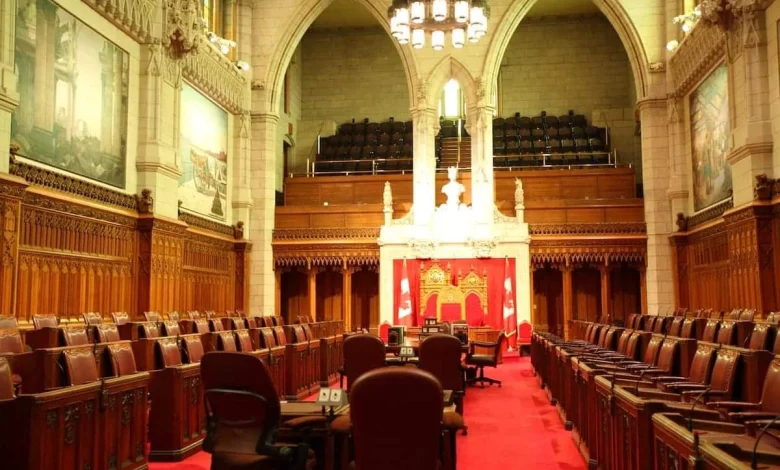Levels Plan: Federal government gives large increase to Provincial Nominee Program, scales back on TFWP and study permits

The Canadian federal government has boosted permanent residency spots under the Provincial Nominee Program (PNP), while scaling back on the Temporary Foreign Worker Program.
In 2026, Canada plans to admit 91,500 permanent residents through the PNP, an increase of 66% from the previous target of 55,000.
The 2026 admissions target for workers under the Temporary Foreign Worker Program (TFWP) has been set at 60,000, down from the previous plan’s target of 82,000.
Assess your eligibility for all Express Entry-aligned PNP streams
On the other hand, planned admissions in 2026 for work permits through the International Mobility Program (IMP) have been set to 170,000, up 32% from the target of 128,700 in last year’s Plan.
The latest plan has significantly reduced overall temporary resident admissions targets, primarily through a near 50% cut to the annual target for international student admissions, which has been set to 155,000 for 2026, down from the previous Plan’s target of 305,900.
Temporary residence annual admissions targets:
2026 (current plan) 2025 2026 (previous plan)
Workers 230,000 367,750 210,700
Students 155,000 305,900 305,900
Total 385,000 673,650 516,600
These changes were announced in the 2026-2028 Immigration Levels Plan, which sets out permanent residence and temporary residence admissions targets for the upcoming year, along with notional targets for the following two years.
Continuing on the trajectory of scaling back on the temporary resident population, the government has established the following annual admissions targets for temporary residents:
2026 2027 2028
Workers – IMP 170,000 170,000 170,000
Workers – TFWP60,000 50,000 50,000
Total workers 230,000 220,000 220,000
Students 155,000 150,000 150,000
Total temporary residents 385,000 370,000 370,000
These temporary residence targets are significantly lower than those established in last year’s Plan, but do not depart significantly from actual admissions numbers seen throughout 2025, in which admissions of international students have fallen 70% relative to last year, and admissions of temporary foreign workers have fallen 50%.
The top-level targets for permanent residence admissions for the year 2026 remain largely unchanged from those in last year’s Plan:
2026 (current plan) 2025 2026 (previous plan)
Economic239,800 232,150229,750
Family reunification 84,000 94,500 88,000
Refugee and humanitarian 56,200 68,350 62,250
Total 380,000 395,000 380,000
Furthermore, the most recent Plan envisions only nominal changes in annual top-level permanent residence admissions targets from 2026 through to 2028:
2026 2027 2028
Economic239,800 244,700 244,700
Family reunification 84,000 81,000 81,000
Refugee and humanitarian 56,200 54,300 54,300
Total 380,000 380,000 380,000
French-speaking admissions outside Quebec 9% (30,267) 9.5% (31,825) 10.5% (35,175)
Discover if You Are Eligible for Canadian Immigration
Provincial Nominee Program
The federal government has significantly expanded the Provincial Nominee Program (PNP) under this year’s Plan relative to last year’s, with the increase to a target of 91,500 permanent residence admissions.
For foreign nationals seeking permanent residency, the increase to the PNP is good news for those in several situations:
- Provincial Nominee candidates being considered in PNP Expression of Interest pools, who have not yet been invited to apply for nomination.
- Foreign nationals who lack high enough Comprehensive Ranking System (CRS) scores to meet the anticipated cut-off scores for draws under Express Entry.
- Foreign nationals who do not qualify for the Canadian Experience Class (CEC).
- Foreign nationals who work in lower-skilled occupations (TEER 4 or 5).
- Foreign nationals seeking permanent residence as business owners rather than as employees (for PNPs with investor and entrepreneur streams).
The increase also has the potential to help foreign nationals with an intent to reside in a province whose PNP excluded their job or industry from eligibility in 2024 in response to reduced allocations, as there is a chance that with higher allocations, PNPs may broaden eligibility.
The PNP, under which provinces and territories can nominate foreign nationals for permanent residence, was the biggest loser in last year’s Plan, which cut 2025 landings targets from 120,000 to 55,000.
Following the cuts to landings targets, the federal government cut PNP nomination allocations by 50% across the board in January of 2025, only to backpedal as the year went on, ultimately increasing allocations for all PNPs except Ontario’s and PEI’s.
The increase to the PNP under Prime Minister Mark Carney and Immigration Minister Lena Diab marks a significant departure from the previous policy under Justin Trudeau and Mark Miller, who, in their October 2024 Levels Plan announcement, had lambasted the provinces for alleged mismanagement of their PNPs over the course of the previous few years.
Work Permits
This year’s Plan increased the top-line admissions targets for work permits even as it scaled back on the Temporary Foreign Worker Program (TFWP), by increasing the landings target for temporary foreign workers issued work permits through the International Mobility Program (IMP).
While the TFWP annual admissions target for 2026 dropped to 60,000, down from 82,000, the IMP annual admissions target for 2026 rose to 170,000, up from 128,700.
Cuts to the TFWP mean reduced flexibility for employers and fewer options for foreign nationals whose post-graduation work permits (PGWPs) are set to expire, and for many mid-career skilled foreign nationals seeking to move to Canada on a work permit from abroad.
This is because the TFWP is the universal, catch-all work permit program, while IMP work permits have more specific criteria, only being issued to foreign nationals who fall under certain situations.
All work permits in Canada fall under either the TFWP or the IMP, between which there are important differences:
Program LMIA required? Program mandate Who is eligible?
TFWP Yes Econonomic, employer-driven Any admissible foreign national
IMP No Economic and cultural Foreign nationals in specific situations only
Schedule a Free Work Permit Consultation with the Cohen Immigration Law Firm
The TFWP is designed to allow employers to hire foreign workers to fill vacant positions for which no Canadian or permanent resident is available. As such, all TFWP work permits require the employer to have obtained a positive or neutral labour market impact assessment (LMIA) from Employment and Social Development Canada (ESDC).
Any admissible foreign national can obtain a TFWP work permit for nearly any occupation and employer in Canada.
All TFWP work permits are closed, and are limited to the employer and position on the work permit.
Due to the general nature of the TFWP program, there is little the government can do to control the number of TFWP work permits issued, so long as employers are able to obtain positive or neutral LMIAs—as we can see in the policy changes of 2024, in which course of action the government took to scale back on TFWP work permits was to raise the wage threshold for the high-wage stream, and issue a moratorium on all low-wage LMIAs in regions with >6% unemployment rates.
The IMP, in contrast, incorporates as part of its mandate both cultural and economic contributions to Canada. For example, the IMP includes International Experience Canada (IEC), a program under which youth from countries with bilateral mobility agreements with Canada can obtain work permits. In exchange, Canadian youth are provided similar opportunities in member countries.
The IMP also includes bridging open work permits (BOWPs), which are issued to foreign nationals with work status in Canada who have applied for permanent residence, and spousal open work permits (SOWPs), issued to spouses of individuals who hold a primary form of status in Canada.
The post-graduation work permit (PGWP) is another flagship IMP open work permit, offering international student graduates the opportunity to live and work in Canada after graduation.
IMP work permits are LMIA-exempt.
The IMP includes both closed work permits, tied to specific employers and occupations, as well as open work permits, which are not tied to any employer, but rather allow holders to work for most employers in most industries in Canada.
The IMP gives the federal government more control over which foreign nationals receive work permits, as the government can keep IMP work permit streams open while adjusting their eligibility to control the supply of work permits—for example, the recent tightening of requirements for PGWPs and SOWPs, which the government intended to result in 325,000 fewer work permit issuances over the subsequent three-year period.
Reduction of temporary resident population
This year’s Plan sets out major decreases in temporary residence admissions targets relative to last year’s Plan.
The government is ratcheting down even further in its efforts to reduce the number of temporary residents as a percentage of Canada’s population to 5% by the end of 2027.
Throughout 2025, we’ve seen the success of government policies, as population growth stalled, and admissions of temporary residents dropped by 50% or more relative to 2024.
Policy changes driving decrease in temporary residents
In 2024, the government introduced a number of policy changes intended to reduce temporary resident levels:
- A cap on study permit applications.
- Removing post-graduation work permit eligibility for graduates of postsecondary programs offered through curriculum licensing agreements.
- Restricting eligibility for PGWPs by adding language proficiency requirements and field of study requirements for non-exempt programs.
- Restricting eligibility for spousal open work permits of international students to spouses of students in doctoral programs, master’s programs of 16 months or longer, and select professional programs such as engineering, nursing, and dentistry.
- Restricting eligibility of spousal open work permits to spouses of temporary foreign workers in the highest-skilled occupations or in select in-demand mid-skilled occupations.
- Implementing a moratorium on the processing of LMIAs under the low-wage stream of the temporary foreign worker program in regions with 6% unemployment or higher.
Many of these policy changes are expected to take years to have their full impact on temporary resident levels.
For example, the reduction in study permits will eventually lead to a reduction in PGWP holders, but may very well take years to have its full impact, since an international student might enroll in a four-year degree program, meaning that the 2025 reduction in study permits may only see its full effect on work permit issuances starting in 2029.
Other changes will see their impact more quickly: the moratorium on low-wage LMIAs prevents the renewal of all expiring work permits within the affected regions. TFWP work permits are often issued for one to two years.
About the Levels Plan
The Immigration Levels Plan forms a portion of the annual report to parliament on immigration, and must be tabled on or before November 1 each year.
Each year’s Plan sets out immigration targets for the upcoming year, and notional targets for the following two years.
Last year’s Plan was the first to include targets for temporary residents – specifically, students and foreign workers.
Not all temporary residents are included in the Plan: the Plan excludes from consideration visitors, tourists, seasonal workers, and asylum seekers.
Breakdown of permanent residence annual admissions targets by program, compared to last year’s plan
2026 targets
2026-2028 Plan 2025 – 2027 Plan
Permanent resident levels
Federal High Skilled 109,000 124,590
Provincial Nominee Program 91,500 55,000
Federal Economic Pilots 8,175 9,920
Atlantic Immigration Program 4,000 5,000
Federal Business 500 1,000
Temporary resident levels
IMP 170,000 128,700
TFWP 60,000 82,000
Total workers 230,000 210,700
Students 155,000 305,900
2027 targets
2026-2028 Plan 2025 – 2027 Plan
Permanent resident levels
Federal High Skilled 111,000 118,730
Provincial Nominee Program 92,500 55,000
Federal Economic Pilots 8,775 9,920
Atlantic Immigration Program 4,000 5,000
Federal Business 500 1,000
Temporary resident levels
IMP 170,000 155,700
TFWP 50,000 82,000
Total workers 220,000 237,700
Students 150,000 305,900
Assess your eligibility for all Express Entry streams




